美国法律体系
美国法律的结构
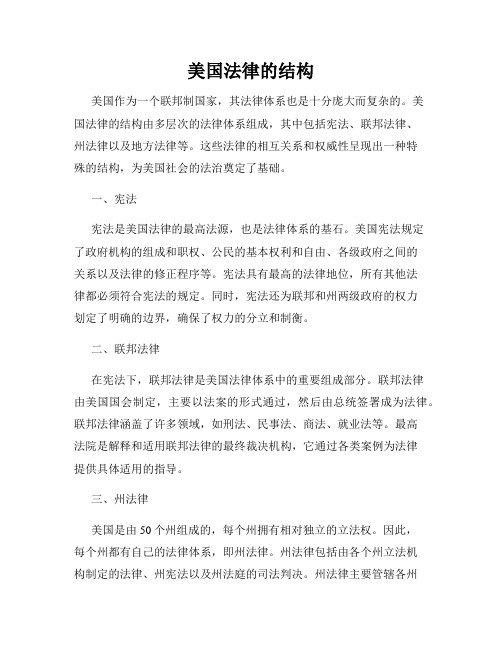
美国法律的结构美国作为一个联邦制国家,其法律体系也是十分庞大而复杂的。
美国法律的结构由多层次的法律体系组成,其中包括宪法、联邦法律、州法律以及地方法律等。
这些法律的相互关系和权威性呈现出一种特殊的结构,为美国社会的法治奠定了基础。
一、宪法宪法是美国法律的最高法源,也是法律体系的基石。
美国宪法规定了政府机构的组成和职权、公民的基本权利和自由、各级政府之间的关系以及法律的修正程序等。
宪法具有最高的法律地位,所有其他法律都必须符合宪法的规定。
同时,宪法还为联邦和州两级政府的权力划定了明确的边界,确保了权力的分立和制衡。
二、联邦法律在宪法下,联邦法律是美国法律体系中的重要组成部分。
联邦法律由美国国会制定,主要以法案的形式通过,然后由总统签署成为法律。
联邦法律涵盖了许多领域,如刑法、民事法、商法、就业法等。
最高法院是解释和适用联邦法律的最终裁决机构,它通过各类案例为法律提供具体适用的指导。
三、州法律美国是由50个州组成的,每个州拥有相对独立的立法权。
因此,每个州都有自己的法律体系,即州法律。
州法律包括由各个州立法机构制定的法律、州宪法以及州法庭的司法判决。
州法律主要管辖各州内的民事和刑事事务,同时在许多领域与联邦法律相互作用。
州法律与联邦法律的关系由宪法的“合同条款”原则控制,即如果州法律与联邦法律存在冲突,联邦法律具有优先权。
四、地方法律除了联邦法律和州法律,地方法律也是美国法律结构的重要组成部分。
地方法律由城市、县和其他地方政府制定,其领域通常涉及城市规划、交通管理、环境保护等。
地方法律由当地政府机构负责执行和维护。
在地方法律与州法律或联邦法律之间存在冲突时,通常会依照法律原则进行权衡和解决。
五、案例法在美国法律体系中,案例法也占据着重要地位。
案例法是以案例和之前的判决作为基础,通过对类似案件的比较和分析,发展法律的一种方法。
最高法院的裁决和其他众多案例通过先例的方式,对未来的法律问题提供了指导。
案例法有助于保持法律的连贯性和稳定性。
美国法律制度

美国法律制度
1) 美国法律的发展
美国法来源于英国法,又根据美国政治、经济和文化特点作了较多的改变。
美国建国初期就制定了成文的联邦宪法,但联邦和各州都自成法律体系。
美国法律制度的发展大约经过了四个时期:殖民地时期的美国法;独立战争后的美国法;南北战争后的美国法;现代美国法。
2)美国法律的性质
它是英美法系的代表,拥有英美法系以英国为中心、以英国普通法为基础;以判例法为主;变革相对缓慢,具有保守性法律发展中法官作用突出;体系庞杂缺乏系统;注重程序的诉讼主义等共同的特点,同时也拥有自身的特点。
3)美国法律的特点
美国建国初期就制定了成文的联邦宪法,但联邦和各州都自成法律体系。
联邦除在国防、外交、财经政策、国际贸易和州际商业等方面外,无统一的立法权;刑事和民商事方面的立法权基本上属于各州。
尽管官方和非官方机构提出过不少供各州立法参考的模范法典草案,但各州采纳程度不一。
路易斯安那州原为法国属地,保留了法国法传统;西南部各州的亲属法则具有法国法和西班牙法的色彩。
4)我个人理解的美国法律的优点
首先是强调程序正义,这保证了法律的公正性和不至于被滥用;
其次是判例制度和成文法结合,具有广泛适用性,不容易被钻了条文的漏洞,也不容易导致权力寻租;
其三是强调人文关怀和教育性,让普通人,尤其是弱势群体有真正被视作“人”而不是被圈养的畜牲。
人道主义源于本来是残酷为本质的“专政”工具法律,确实让人有点敬仰;
其四是公民陪审团制度,保证了法律不会成为某个统治阶层的专有工具,一定程度上保证了社会正义的可能性。
解析美国法律的特点及司法制度
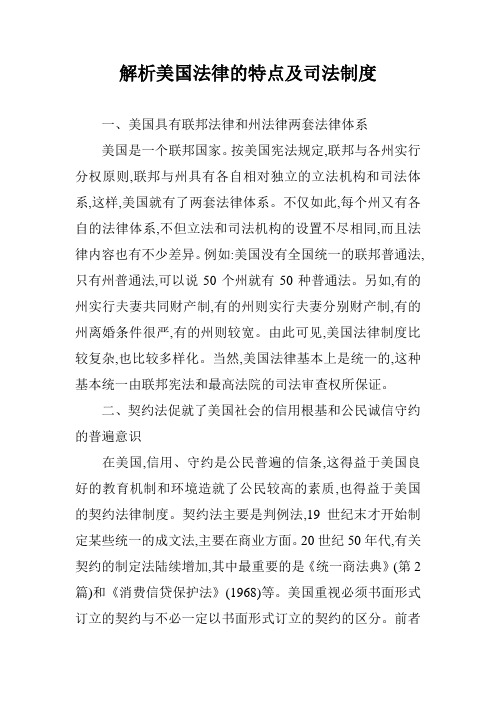
解析美国法律的特点及司法制度一、美国具有联邦法律和州法律两套法律体系美国是一个联邦国家。
按美国宪法规定,联邦与各州实行分权原则,联邦与州具有各自相对独立的立法机构和司法体系,这样,美国就有了两套法律体系。
不仅如此,每个州又有各自的法律体系,不但立法和司法机构的设置不尽相同,而且法律内容也有不少差异。
例如:美国没有全国统一的联邦普通法,只有州普通法,可以说50个州就有50种普通法。
另如,有的州实行夫妻共同财产制,有的州则实行夫妻分别财产制,有的州离婚条件很严,有的州则较宽。
由此可见,美国法律制度比较复杂,也比较多样化。
当然,美国法律基本上是统一的,这种基本统一由联邦宪法和最高法院的司法审查权所保证。
二、契约法促就了美国社会的信用根基和公民诚信守约的普遍意识在美国,信用、守约是公民普遍的信条,这得益于美国良好的教育机制和环境造就了公民较高的素质,也得益于美国的契约法律制度。
契约法主要是判例法,19世纪末才开始制定某些统一的成文法,主要在商业方面。
20世纪50年代,有关契约的制定法陆续增加,其中最重要的是《统一商法典》(第2篇)和《消费信贷保护法》(1968)等。
美国重视必须书面形式订立的契约与不必一定以书面形式订立的契约的区分。
前者包括超500美元的买卖契约、不动产契约、履行期限超过一年的契约、承诺在儿女结婚时转移财产的契约,以及遗产管理人承诺以自己财产支付死者债务的契约等;不以书面形式订立的契约必须有契约成因,即以交易为内容,因而无偿赠与虽可在事实上履行,却不能作为契约成因,不产生请求权。
三、在立法和法院判决上保护弱者是美国法律的重要特点美国宪法修正案第一条规定:“国会不得制定法律:剥夺言论或出版自由,或人民和平集会或申请政府伸冤的权利。
”宪法的这一规定使政府阻止任何发言或出版的行为不合法,并限制政府因某人曾发言(撰)文而随意受到追究。
立法者的立法旨意非常明显:讨论公务不受任何限制。
法院判决也显不同:某报对电影演员的批评失实,损害其名誉权,判赔100万美元;而批评议员州长失实则判罚1美元。
美国司法制度原则

美国司法制度原则美国司法制度是美国宪法所确立的一套法律和政府机构体系,旨在维护公正和平等的司法体系。
这个制度以保障公民的基本权利和自由为首要任务,包括民事纠纷和刑事犯罪的审判和裁决。
下面将探讨美国司法制度的核心原则。
1. 法律的统治美国司法制度的核心原则之一是法律的统治。
这意味着法律是最高的权威,并适用于所有的公民和政府机构。
司法机构的职责是根据法律对案件进行公正和平等的审理,并根据法律作出裁决。
司法机构的判断不应受到政治、经济或其他外部因素的干扰。
2. 公正和平等美国司法制度的另一个核心原则是公正和平等。
这意味着每个人在法律面前都应得到平等对待和公正的审判。
无论种族、性别、宗教或经济地位如何,每个人都有权利在法庭上表达自己的观点,并接受公正的判断。
司法机构必须保证审判的公正性和中立性,确保每个被告和原告都有平等的机会以及公正的程序。
3. 权力分立与制衡美国司法制度的另一重要原则是权力的分立与制衡。
根据美国宪法,立法、行政和司法权力被分为三个独立而平等的机构:国会、行政部门和司法部门。
这种分权的设计旨在防止某一机构或个人滥用权力。
司法部门的职责是解释法律的含义并进行审判,以确保宪法的正确执行。
4. 被控人的权利保障美国司法制度重视保障被告人的权利。
被告人享有自由和公正的审判,有权保持沉默、聘请辩护律师以及与证人进行交叉盘问。
此外,被告人有权利不受非法搜查和逮捕,并保有不受酷刑和残忍对待的权利。
这些权利的保障旨在确保司法程序的公正性和合法性。
5. 公众参与和透明度美国司法制度注重公众参与和透明度。
庭审和审判是公众的权力和监督对象。
开庭审理和判决过程通常是公开的,以确保公正和透明。
公众也有权利访问司法文件和决策,以保证司法系统的透明度和公信力。
6. 意见表达和司法独立美国司法制度保障了言论自由和意见表达的权利。
公众对司法判决和司法政策有权提出批评和反对意见,并有权在法律允许的范围内通过合法途径争取公正和平等待遇。
美国的立法体制
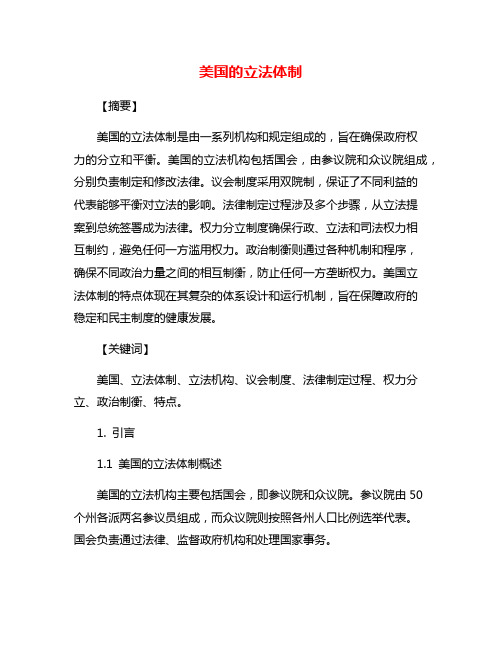
美国的立法体制【摘要】美国的立法体制是由一系列机构和规定组成的,旨在确保政府权力的分立和平衡。
美国的立法机构包括国会,由参议院和众议院组成,分别负责制定和修改法律。
议会制度采用双院制,保证了不同利益的代表能够平衡对立法的影响。
法律制定过程涉及多个步骤,从立法提案到总统签署成为法律。
权力分立制度确保行政、立法和司法权力相互制约,避免任何一方滥用权力。
政治制衡则通过各种机制和程序,确保不同政治力量之间的相互制衡,防止任何一方垄断权力。
美国立法体制的特点体现在其复杂的体系设计和运行机制,旨在保障政府的稳定和民主制度的健康发展。
【关键词】美国、立法体制、立法机构、议会制度、法律制定过程、权力分立、政治制衡、特点。
1. 引言1.1 美国的立法体制概述美国的立法机构主要包括国会,即参议院和众议院。
参议院由50个州各派两名参议员组成,而众议院则按照各州人口比例选举代表。
国会负责通过法律、监督政府机构和处理国家事务。
美国的议会制度采取两院制,意味着任何法案必须经过参议院和众议院的通过才能成为法律。
这种制度体现了分权与合作的理念,保障了各州和民众的利益。
美国的法律制定过程复杂而民主,法案通常由议员或政府提出,然后经过委员会审查、辩论和投票,最终需要总统签署成为法律。
美国的权力分立体现在行政、立法和司法三大分支之间相互制衡,互相监督,避免了权力过分集中的问题。
政治制衡则在于各政党、利益集团和民众之间的博弈和平衡。
美国的立法体制具有独特的特点,体现了权力分立、政治制衡和民主法治的原则。
通过国会的议会制度和法律制定过程,美国政府能够有效监督和管控国家事务,保障民众权益,促进国家发展。
2. 正文2.1 美国的立法机构美国的立法机构包括国会、参议院和众议院。
国会是美国的最高立法机构,由参议院和众议院两个分支组成。
参议院和众议院分别代表各州和各选区的利益,具有相互制衡的关系。
参议院由每个州的两名参议员组成,任期为6年。
参议院的成员被称为参议员,他们在立法过程中起着重要作用,例如审议和通过法案、认可外交协议等。
美国法与司法体系
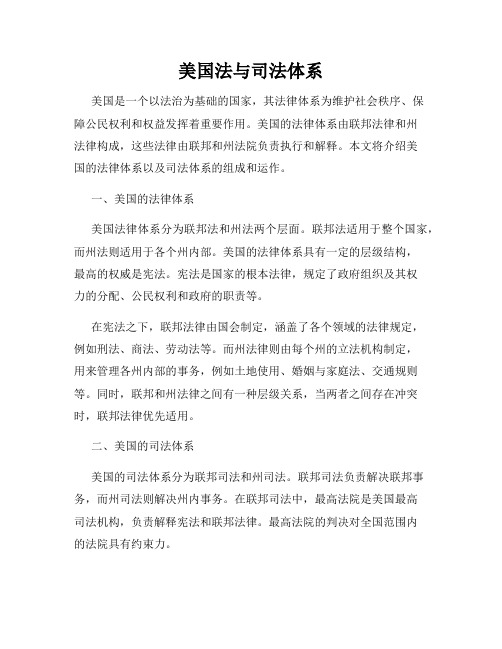
美国法与司法体系美国是一个以法治为基础的国家,其法律体系为维护社会秩序、保障公民权利和权益发挥着重要作用。
美国的法律体系由联邦法律和州法律构成,这些法律由联邦和州法院负责执行和解释。
本文将介绍美国的法律体系以及司法体系的组成和运作。
一、美国的法律体系美国法律体系分为联邦法和州法两个层面。
联邦法适用于整个国家,而州法则适用于各个州内部。
美国的法律体系具有一定的层级结构,最高的权威是宪法。
宪法是国家的根本法律,规定了政府组织及其权力的分配、公民权利和政府的职责等。
在宪法之下,联邦法律由国会制定,涵盖了各个领域的法律规定,例如刑法、商法、劳动法等。
而州法律则由每个州的立法机构制定,用来管理各州内部的事务,例如土地使用、婚姻与家庭法、交通规则等。
同时,联邦和州法律之间有一种层级关系,当两者之间存在冲突时,联邦法律优先适用。
二、美国的司法体系美国的司法体系分为联邦司法和州司法。
联邦司法负责解决联邦事务,而州司法则解决州内事务。
在联邦司法中,最高法院是美国最高司法机构,负责解释宪法和联邦法律。
最高法院的判决对全国范围内的法院具有约束力。
除了最高法院外,联邦法院还包括上级法院、地区法院和特殊法院。
上级法院是区域性的联邦法院,负责审理上诉案件。
地区法院则是联邦司法体系的基层法院,主要负责审理刑事和民事案件。
特殊法院则处理特定类型的案件,例如移民法院和海军军事法庭等。
州司法体系由各个州的法院组成,包括州最高法院、上诉法院、地方法院等。
州最高法院是每个州的最高司法机构,负责解释各州法律和宪法。
上诉法院则是各州法院系统的中级法院,负责审理递上来的上诉案件。
地方法院是各州的基层法院,负责审理刑事和民事案件。
三、美国司法体系的运作美国的司法体系采用了审判制度,即通过法官进行裁决的方式来解决纠纷和争议。
审判程序包括起诉、辩论、证据交换和判决等环节。
双方当事人可以聘请律师代表自己,进行法庭诉讼。
在美国司法体系中,法官是关键的执法者和决策者。
美国法律体系案例(3篇)
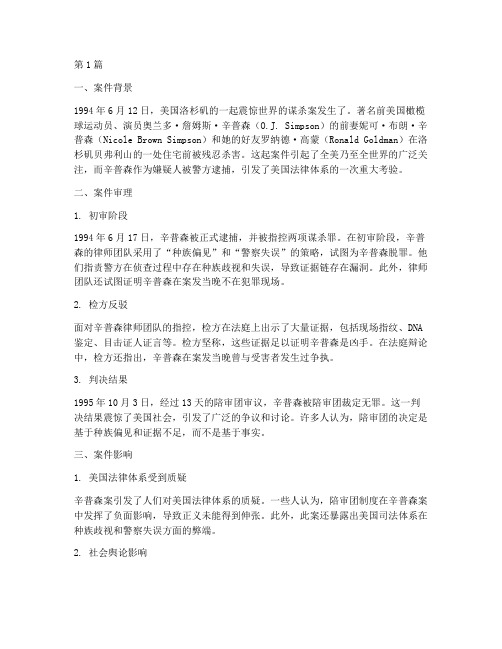
第1篇一、案件背景1994年6月12日,美国洛杉矶的一起震惊世界的谋杀案发生了。
著名前美国橄榄球运动员、演员奥兰多·詹姆斯·辛普森(O.J. Simpson)的前妻妮可·布朗·辛普森(Nicole Brown Simpson)和她的好友罗纳德·高蒙(Ronald Goldman)在洛杉矶贝弗利山的一处住宅前被残忍杀害。
这起案件引起了全美乃至全世界的广泛关注,而辛普森作为嫌疑人被警方逮捕,引发了美国法律体系的一次重大考验。
二、案件审理1. 初审阶段1994年6月17日,辛普森被正式逮捕,并被指控两项谋杀罪。
在初审阶段,辛普森的律师团队采用了“种族偏见”和“警察失误”的策略,试图为辛普森脱罪。
他们指责警方在侦查过程中存在种族歧视和失误,导致证据链存在漏洞。
此外,律师团队还试图证明辛普森在案发当晚不在犯罪现场。
2. 检方反驳面对辛普森律师团队的指控,检方在法庭上出示了大量证据,包括现场指纹、DNA 鉴定、目击证人证言等。
检方坚称,这些证据足以证明辛普森是凶手。
在法庭辩论中,检方还指出,辛普森在案发当晚曾与受害者发生过争执。
3. 判决结果1995年10月3日,经过13天的陪审团审议,辛普森被陪审团裁定无罪。
这一判决结果震惊了美国社会,引发了广泛的争议和讨论。
许多人认为,陪审团的决定是基于种族偏见和证据不足,而不是基于事实。
三、案件影响1. 美国法律体系受到质疑辛普森案引发了人们对美国法律体系的质疑。
一些人认为,陪审团制度在辛普森案中发挥了负面影响,导致正义未能得到伸张。
此外,此案还暴露出美国司法体系在种族歧视和警察失误方面的弊端。
2. 社会舆论影响辛普森案引发了美国社会对种族歧视、犯罪和司法公正的广泛讨论。
许多人在此案中看到了美国社会存在的问题,并呼吁改革法律体系和加强司法公正。
3. 辛普森个人形象受损尽管辛普森在法庭上被判无罪,但此案对他的个人形象造成了极大的损害。
美国的规章制度
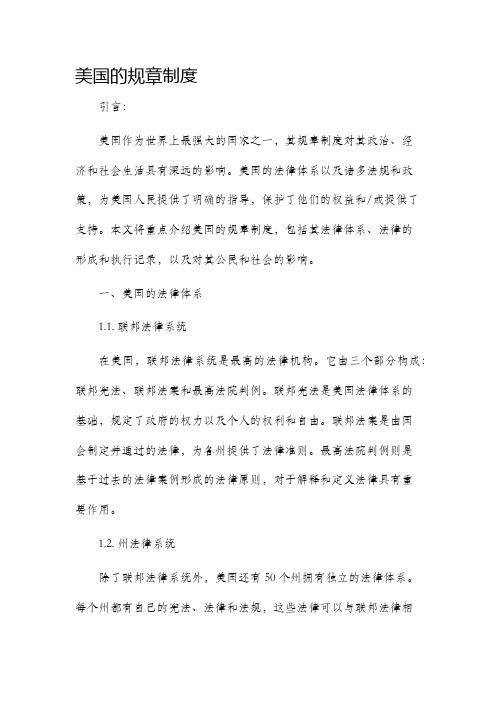
美国的规章制度引言:美国作为世界上最强大的国家之一,其规章制度对其政治、经济和社会生活具有深远的影响。
美国的法律体系以及诸多法规和政策,为美国人民提供了明确的指导,保护了他们的权益和/或提供了支持。
本文将重点介绍美国的规章制度,包括其法律体系、法律的形成和执行记录,以及对其公民和社会的影响。
一、美国的法律体系1.1. 联邦法律系统在美国,联邦法律系统是最高的法律机构。
它由三个部分构成:联邦宪法、联邦法案和最高法院判例。
联邦宪法是美国法律体系的基础,规定了政府的权力以及个人的权利和自由。
联邦法案是由国会制定并通过的法律,为各州提供了法律准则。
最高法院判例则是基于过去的法律案例形成的法律原则,对于解释和定义法律具有重要作用。
1.2. 州法律系统除了联邦法律系统外,美国还有50个州拥有独立的法律体系。
每个州都有自己的宪法、法律和法规,这些法律可以与联邦法律相补充或限制。
州法律系统在诸多方面独立于联邦法律系统,并根据各州的具体需求制定法律。
二、法律的形成和执行记录2.1. 立法过程在美国,立法过程从一个具体的提案到成为法律的过程是复杂且严格的。
立法者通常由国会、联邦政府或州议会选出。
立法者将提出一项法案,该法案经过辩论、修改和投票,最后由立法者对法案进行表决。
如果法案获得了足够的支持,它将被送至总统或州长签署成为法律。
2.2. 法律的执行和司法过程一旦法律通过立法过程并签署成为法律,执行和司法过程便开始。
在美国,执行官员负责确保法律得以执行。
他们可以通过制定具体的政策和指南来解释和执行法律。
司法部门则负责审理违反法律的案件。
当有人被指控违反法律时,他们将经历诉讼过程,最终由法官认定是否有罪并宣判刑罚。
三、美国规章制度对公民和社会的影响3.1. 保护公民权利和自由美国的规章制度强调保护公民的权利和自由。
联邦宪法规定了公民的基本权利,例如言论自由、宗教自由和平等权利。
通过立法和司法程序,美国一直努力确保公民享有这些基本权利。
美国法律体系介绍
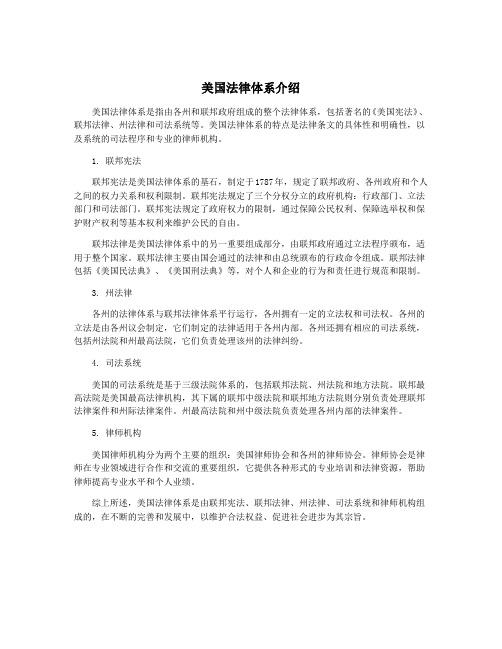
美国法律体系介绍美国法律体系是指由各州和联邦政府组成的整个法律体系,包括著名的《美国宪法》、联邦法律、州法律和司法系统等。
美国法律体系的特点是法律条文的具体性和明确性,以及系统的司法程序和专业的律师机构。
1. 联邦宪法联邦宪法是美国法律体系的基石,制定于1787年,规定了联邦政府、各州政府和个人之间的权力关系和权利限制。
联邦宪法规定了三个分权分立的政府机构:行政部门、立法部门和司法部门。
联邦宪法规定了政府权力的限制,通过保障公民权利、保障选举权和保护财产权利等基本权利来维护公民的自由。
联邦法律是美国法律体系中的另一重要组成部分,由联邦政府通过立法程序颁布,适用于整个国家。
联邦法律主要由国会通过的法律和由总统颁布的行政命令组成。
联邦法律包括《美国民法典》、《美国刑法典》等,对个人和企业的行为和责任进行规范和限制。
3. 州法律各州的法律体系与联邦法律体系平行运行,各州拥有一定的立法权和司法权。
各州的立法是由各州议会制定,它们制定的法律适用于各州内部。
各州还拥有相应的司法系统,包括州法院和州最高法院,它们负责处理该州的法律纠纷。
4. 司法系统美国的司法系统是基于三级法院体系的,包括联邦法院、州法院和地方法院。
联邦最高法院是美国最高法律机构,其下属的联邦中级法院和联邦地方法院则分别负责处理联邦法律案件和州际法律案件。
州最高法院和州中级法院负责处理各州内部的法律案件。
5. 律师机构美国律师机构分为两个主要的组织:美国律师协会和各州的律师协会。
律师协会是律师在专业领域进行合作和交流的重要组织,它提供各种形式的专业培训和法律资源,帮助律师提高专业水平和个人业绩。
综上所述,美国法律体系是由联邦宪法、联邦法律、州法律、司法系统和律师机构组成的,在不断的完善和发展中,以维护合法权益、促进社会进步为其宗旨。
美国法律体系的特点

美国法律体系的特点1.美国成文法基本上是州一级的法律。
2.除了民事诉讼课程是联邦法,美国法学院第一年的课程几乎都是州法律。
3.陪审团制度是美国法律的一个特征,它是美国法不仅区别于大陆法系甚至区别于英国普通法。
4.两套平行的系统:州法院适用州法律,联邦法院适用联邦法律。
州法院有权力适用州法律,包括州宪法。
所有联邦法院都适用州法律。
5.只有当案件上升到联邦问题的程度,或考虑到某案涉及公民的异籍身份问题,联邦法院才介入。
6.美国法官走的是全方位路线,大陆法系法官走的是专业化路线。
7.美国的司法审判中,实行当事人主义,法官不需要对争议事实进行认证和裁决。
8.美国法律系统的权力是分散的,它的运行依靠的是各个平等权力主体之间的相互协调。
9.上诉案件原则上都是法律审,很少涉及事实审10.美国法学院的教育以培养律师为目的11.案件记录是美国法学院的授课内容之一12.实用主义哲学影响深远,现实精神和经验分析是美国法律思想的基本特征马伯里诉麦迪逊案(1803)确立司法审查制度最高法院首次行使司法审查权并使国会一项法律无效马歇尔确立了由永久性的成文宪法支配临时性的国会的基本原则司法审查已经成为我们宪法机器中绝对必要的部件,抽掉这一个特制的螺栓,这部机器就化为碎片。
罗伊诉韦德Opinion 法官判决意见:The Supreme Court of the United States decided that states could regulate abortions only in certain circumstances but otherwise women did have a right to privacy and reproductive autonomy.美国联邦最高法院判决妇女拥有自主隐私和决定生育的权利,州政府只有在特定情形下才可以立法规范妇女堕胎问题。
美国联邦最高法院把妇女的孕期分为三个阶段,确定了孕妇和州政府各自拥有的权利。
美国的规章制度和中国

美国的规章制度和中国首先,美国的规章制度体系分为联邦法和州法两个部分。
联邦法是整个国家范围内的法律,是总统和国会通过的法律。
而州法是各个州制定的法律,适用于各自的州内。
美国的法律体系十分严谨,各个法律之间相互协调,共同构成了一个完整的法治体系。
中国的规章制度也分为中央法和地方法两个部分。
中央法是由中央政府颁布的法律,适用于全国范围。
地方法是由各地方政府颁布的法律,适用于各自的省份或者市县。
中国的法律体系也是一个高度集权的体系,中央政府在法律颁布和执行方面扮演着主导角色。
美国的联邦法是由国会通过的,而中国的中央法是由全国人大通过的。
国会和全国人大都是各自国家的最高立法机构,负责通过和修订法律。
这两个机构在各自国家的法律体系中具有至关重要的地位,是维护法律权威和法治精神的中流砥柱。
美国的法律体系也包括了一系列的监督和制衡机制,以确保法律的公正和合法性。
最高法院是美国最高的司法机构,负责解释宪法和审理具有重大影响的案件。
美国的监督机制包括了三权分立,司法独立等制度保障措施,确保了法律的有效实施和公平执行。
中国的法律体系也拥有类似的监督和制衡机制,以确保法律的正确实施和公正执行。
最高人民法院是中国最高的司法机构,负责审理最高法院和最高检察院直接提审或者重大影响民事、刑事和行政案件,履行最高司法监督职权。
中国的监督机制包括了审判监督、行政监督等制度保障措施,确保了法律的正确实施和公正执行。
在具体的法律领域中,美国和中国的规章制度也有一些不同之处。
比如在知识产权保护方面,美国重视知识产权的保护,通过完善的专利、商标、著作权等法律来保护创新和知识产权。
而中国也加大了知识产权保护的力度,增设了专利法院等机构,以提高知识产权维权的效率。
另外,在环境保护方面,美国和中国的规章制度也有一些共同之处。
美国的环保法律体系非常完善,包括了清洁空气法、清洁水法等法律法规,致力于保护环境和自然资源。
中国也通过颁布了《环境保护法》、《水污染防治法》等法律,加大了对环境保护的力度,推动了环保事业的发展。
美国的国家制度
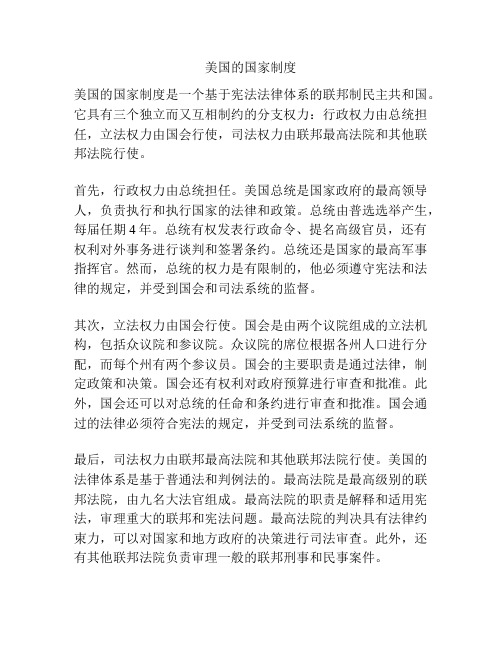
美国的国家制度美国的国家制度是一个基于宪法法律体系的联邦制民主共和国。
它具有三个独立而又互相制约的分支权力:行政权力由总统担任,立法权力由国会行使,司法权力由联邦最高法院和其他联邦法院行使。
首先,行政权力由总统担任。
美国总统是国家政府的最高领导人,负责执行和执行国家的法律和政策。
总统由普选选举产生,每届任期4年。
总统有权发表行政命令、提名高级官员,还有权利对外事务进行谈判和签署条约。
总统还是国家的最高军事指挥官。
然而,总统的权力是有限制的,他必须遵守宪法和法律的规定,并受到国会和司法系统的监督。
其次,立法权力由国会行使。
国会是由两个议院组成的立法机构,包括众议院和参议院。
众议院的席位根据各州人口进行分配,而每个州有两个参议员。
国会的主要职责是通过法律,制定政策和决策。
国会还有权利对政府预算进行审查和批准。
此外,国会还可以对总统的任命和条约进行审查和批准。
国会通过的法律必须符合宪法的规定,并受到司法系统的监督。
最后,司法权力由联邦最高法院和其他联邦法院行使。
美国的法律体系是基于普通法和判例法的。
最高法院是最高级别的联邦法院,由九名大法官组成。
最高法院的职责是解释和适用宪法,审理重大的联邦和宪法问题。
最高法院的判决具有法律约束力,可以对国家和地方政府的决策进行司法审查。
此外,还有其他联邦法院负责审理一般的联邦刑事和民事案件。
美国的国家制度体现了分权与制衡的原则,旨在确保政府的权力不被滥用或过度集中。
不同的机构之间存在着相互独立和相互制约的关系,相互协作以完成各自的职责和义务。
这样的制度设计有助于保护公民的权利和自由,并确保政府的合法性和责任性。
总结起来,美国的国家制度是一个基于宪法法律体系的联邦制民主共和国,其中行政权力由总统担任,立法权力由国会行使,司法权力由联邦最高法院和其他联邦法院行使。
这个制度旨在确保政府的权力得到限制和制衡,以保护公民的权利和自由。
美国的法律制度

美国的法律制度美国的法律制度是基于宪法的法治体系。
宪法是美国最高法律文件,确立了政府权力的分工和限制,保障了公民的权利与自由。
美国的法律体系分为联邦法和州法。
联邦法适用于整个国家,而州法则只适用于各自的州。
联邦法律主要由国会通过,由总统签署成为法律。
联邦最高法院负责解释宪法和联邦法律,并在需要时对其进行审查。
州法律由各州的立法机构通过,并由各州州长签署成为法律。
美国的法律制度是一体化的,并且特别注重司法独立和平衡。
司法分为联邦和州两级,联邦最高法院是最高司法机构。
最高法院由九位大法官组成,由总统提名并经参议院确认任命。
最高法院对于联邦和州法律的解释具有极高的权威性。
其他的联邦和州法院则依次排列,逐级审查和解决案件。
美国的法律制度强调对个人权利和自由的保护。
首修宪法中的前十条修正案,即美国宪法的“权利法案”,明确规定了公民的自由权利,如言论自由、宗教自由、新闻自由、和平集会自由、武器持有权等等。
法律也保护公民免于不公平的对待、违法拘禁和残酷、不人道的处罚。
这些权利通过司法程序得到保障,公民可以通过起诉和上诉来维护自己的权益。
美国的法律制度注重公正和平等原则。
法律适用于所有公民,不分种族、性别、宗教、国籍等等。
所有人都有平等的机会接受公正的审判,并且法律保护弱势群体的权益。
司法系统确保每个人都有权利在法庭上辩护,并有权利获得律师代表。
此外,美国法律制度还包括法律规则和程序,以确保司法程序的公正、透明和高效。
法官和陪审员的中立性和独立性是法治体系的关键原则。
法院在处理案件时遵循严格的程序和证据规则,以确保证据的真实性和可靠性。
总的来说,美国的法律制度是建立在宪法基础上的法治体系,旨在保护个人权利和自由,追求公正和平等,强调司法独立和平衡,并通过法律规则和程序来确保司法的公正和透明。
这个法律体系为美国社会的稳定和公民的权益提供了坚实的保障。
美国法律制度的历史演变与实践

美国法律制度的历史演变与实践法律是一个国家的灵魂,它是维护社会秩序,保障公民权益不可或缺的基石。
美国作为一个以法制为基础的国家,其法律制度的发展历程具有特殊的意义。
本文将基于美国法律制度的历史演变和实践,阐述其对于当代法律制度的借鉴与启示。
一、美国法律制度的发展历程1.殖民地时期美国法律制度的历史可追溯到殖民地时期。
当时的美洲大陆上,存在着不同的英国殖民地,各殖民地间法律存在明显的不同,尤其是在土地权、民事法和刑法等方面存在很大的分歧。
这也为后来独立战争后美国成为一个真正意义上的国家,奠定了法律制度的基础。
2.建国初期1776年,美国宣布独立,成立独立的国家。
在建立新的政府体系的过程中,美国的立法者起草了宪法,确立了美国宪政体系。
美国宪法规定了联邦政府的三个关键机构:立法机构、行政机构和司法机构。
在这一机构体系下,美国法律制度开始逐渐完善。
3.民主扩展与反歧视法律制度19世纪,美国正处于工业化和城市化进程中,由此带来的社会问题与矛盾日益突出。
在此时期,美国法律制度不仅推出了若干立法法案,如《反奴隶制法》等,还修改了部分原有法律,以适应民主扩展与反歧视的需要。
4.20世纪以来20世纪起,美国法律制度逐渐变得更加成熟和完善,同时也面临着严峻的挑战。
例如,美国的刑法体系长期以来存在着决策不公和执行不力等问题,导致了许多冤假错案的出现。
在这一背景下,美国法律界积极探索创新性的改革路径,旨在进一步提升法制水平。
二、美国法律制度的实践1.以合法主义为核心美国的法律制度一直以来都遵循着合法主义的理念,即法律是国家制定和实施的,只有被立法机构和司法机构依法制定并公正实施的法律,才是有效的法律。
2.奉行权利保护美国法律制度强调尊重个人权利和自由,特别是在宪法中确立了言论自由、信仰自由、选举权、权利保护等基本权利。
3.强调司法独立美国法律制度强调司法独立和公正,各级法院的独立程度高,且法官的选拔和任命非常严谨。
4.推行创新改革美国法律制度一直是全球创新性的法律制度之一,包括民众法庭、和解、民事调解、调解仲裁等多个领域的创新特点。
美国法律引注体系统一化简史
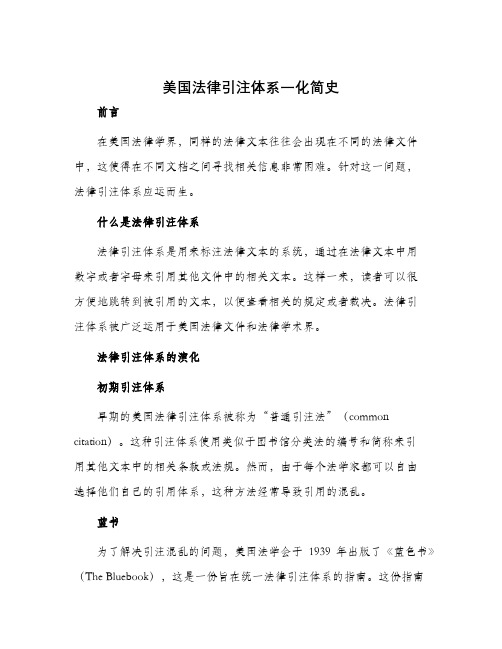
美国法律引注体系一化简史前言在美国法律学界,同样的法律文本往往会出现在不同的法律文件中,这使得在不同文档之间寻找相关信息非常困难。
针对这一问题,法律引注体系应运而生。
什么是法律引注体系法律引注体系是用来标注法律文本的系统,通过在法律文本中用数字或者字母来引用其他文件中的相关文本。
这样一来,读者可以很方便地跳转到被引用的文本,以便查看相关的规定或者裁决。
法律引注体系被广泛运用于美国法律文件和法律学术界。
法律引注体系的演化初期引注体系早期的美国法律引注体系被称为“普通引注法”(common citation)。
这种引注体系使用类似于图书馆分类法的编号和简称来引用其他文本中的相关条款或法规。
然而,由于每个法学家都可以自由选择他们自己的引用体系,这种方法经常导致引用的混乱。
蓝书为了解决引注混乱的问题,美国法学会于1939年出版了《蓝色书》(The Bluebook),这是一份旨在统一法律引注体系的指南。
这份指南规定每个引注包括作者名称、书名、版次、出版地、出版商以及出版年份等。
此外,该指南还描述了使用数字和字母对文本进行标记的规则以及不同类型文献的标准格式。
蓝书的局限性随着时间的推移,人们意识到蓝书虽然在一定程度上解决了引注混乱问题,但是它的管理和更新工作也变得越来越困难。
因此,对蓝书的指导和管理变得分散且混乱,这也使得参考蓝书的出版物和引文不够准确。
建立统一拟议的法律引注体系出于这种问题,1990年代,美国法学界暨出版业协会制定了一种新的基于数字的法律引注体系。
该引注体系被称为统一拟议的法律引注体系(Uniform System of Citation),简称“蓝书第19版”。
这个新体系通过引用在线数据库、模板以及其他工具,统一了引注格式和规则。
这样做使得引注体系的稍小变更可以在一个中央位置进行更新,这样可以更容易地保持正确性和及时性。
结论通过不断的演化和完善,现在的美国法律引注体系越来越简洁、规范化以及易于管理。
美国的法院体系和司法原则
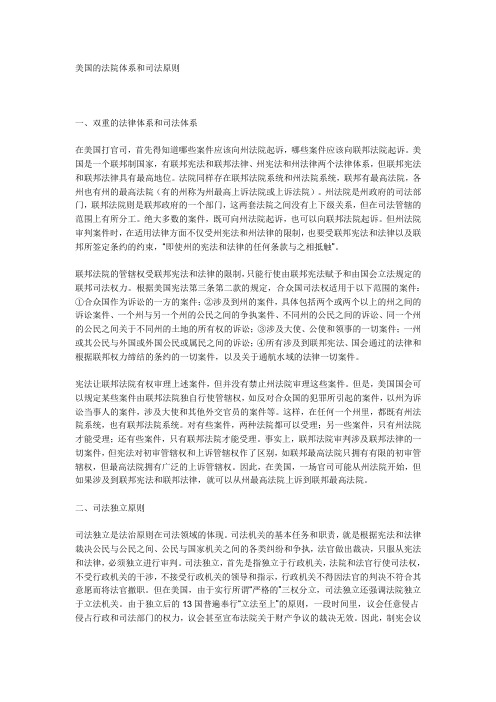
美国的法院体系和司法原则一、双重的法律体系和司法体系在美国打官司,首先得知道哪些案件应该向州法院起诉,哪些案件应该向联邦法院起诉。
美国是一个联邦制国家,有联邦宪法和联邦法律、州宪法和州法律两个法律体系,但联邦宪法和联邦法律具有最高地位。
法院同样存在联邦法院系统和州法院系统,联邦有最高法院,各州也有州的最高法院(有的州称为州最高上诉法院或上诉法院)。
州法院是州政府的司法部门,联邦法院则是联邦政府的一个部门,这两套法院之间没有上下级关系,但在司法管辖的范围上有所分工。
绝大多数的案件,既可向州法院起诉,也可以向联邦法院起诉。
但州法院审判案件时,在适用法律方面不仅受州宪法和州法律的限制,也要受联邦宪法和法律以及联邦所签定条约的约束,“即使州的宪法和法律的任何条款与之相抵触”。
联邦法院的管辖权受联邦宪法和法律的限制,只能行使由联邦宪法赋予和由国会立法规定的联邦司法权力。
根据美国宪法第三条第二款的规定,合众国司法权适用于以下范围的案件:①合众国作为诉讼的一方的案件;②涉及到州的案件,具体包括两个或两个以上的州之间的诉讼案件、一个州与另一个州的公民之间的争执案件、不同州的公民之间的诉讼、同一个州的公民之间关于不同州的土地的所有权的诉讼;③涉及大使、公使和领事的一切案件;一州或其公民与外国或外国公民或属民之间的诉讼;④所有涉及到联邦宪法、国会通过的法律和根据联邦权力缔结的条约的一切案件,以及关于通航水域的法律一切案件。
宪法让联邦法院有权审理上述案件,但并没有禁止州法院审理这些案件。
但是,美国国会可以规定某些案件由联邦法院独自行使管辖权,如反对合众国的犯罪所引起的案件,以州为诉讼当事人的案件,涉及大使和其他外交官员的案件等。
这样,在任何一个州里,都既有州法院系统,也有联邦法院系统。
对有些案件,两种法院都可以受理;另一些案件,只有州法院才能受理;还有些案件,只有联邦法院才能受理。
事实上,联邦法院审判涉及联邦法律的一切案件,但宪法对初审管辖权和上诉管辖权作了区别,如联邦最高法院只拥有有限的初审管辖权,但最高法院拥有广泛的上诉管辖权。
- 1、下载文档前请自行甄别文档内容的完整性,平台不提供额外的编辑、内容补充、找答案等附加服务。
- 2、"仅部分预览"的文档,不可在线预览部分如存在完整性等问题,可反馈申请退款(可完整预览的文档不适用该条件!)。
- 3、如文档侵犯您的权益,请联系客服反馈,我们会尽快为您处理(人工客服工作时间:9:00-18:30)。
1General overview
2 1.1 Sources of law
3 1.2 Constitutionality
∙ 2 American common law
∙ 3 Levels of law
1 3.1 Federal law
2 3.1.1 Federal statutory
enactment procedure
▪ 3.1.2 Federal
regulatory
promulgation
procedure
▪ 3.1.3 Formulation of
federal precedent
3 3.2 State law
▪ 3.2.1 Attempts at
"uniform" laws
4 3.3 Local law
∙ 4 Types of law
1 4.1 Procedural law
▪ 4.1.1 Criminal
procedure
▪ 4.1.2 Civil
procedure
2 4.2 Substantive law
▪ 4.2.1 Criminal law
▪ 4.2.2 Contract law
▪ 4.2.3 Tort law
∙ 5 Odd exceptions
∙ 6 See also
1 6.1 Lists
∙7 References
∙8 Further reading
∙9 External links
•1概览
1.1法的渊源
Ø 1.2合宪
•2美国普通法
•3法律层次
Ø 3.1联邦法律
3.1.1联邦法定程序制定♣3.1.2联邦法规的颁布程序♣3.1.3制定联邦先例♣
Ø 3.2州际法律
3.2.1“统一”的法律企图♣
Ø 3.3当地法律
•4法律类型
Ø 4.1程序法
4.1.1刑事诉讼程序♣
4.1.2民事程序♣
Ø 4.2实体法
4.2.1刑法♣
4.2.2合同法♣
4.2.3侵权法♣
•5稀奇古怪的例外
•6参见
Ø 6.1列表
•7参考资料
•8延伸阅读
•9外部链接
The law of the United States consists of many levels[1] of codified and uncodified forms of law, of which the most important is the United States Constitution, the foundation of the federal government of the United States. The Constitution sets out the boundaries of federal law, which consists of constitutional acts of Congress, constitutional treaties ratified by Congress, constitutional regulations promulgated by the executive branch, and case law originating from the federal judiciary.
1、The Constitution and federal law are the supreme law of the land, thus circumscribing限制state and territorial laws in the fifty U.S. states and in the territories.
[2] In the unique dual双重的-sovereign元首system of American federalism (actually tripartite when one includes Indian reservations), states are the plenary充分的sovereigns, while the federal sovereign possesses only the limited supreme authority enumerated in the Constitution. Indeed, states may grant their citizens broader rights than the federal Constitution as long as they do not infringe破坏on any federal constitutional rights.
[3] Thus, most U.S. law (especially the actual "living law" of contract, tort, criminal, and family law experienced by the majority of citizens on a day-to-day basis) consists primarily of state law, which can and does vary greatly from one state to the next.[4][5]
The most important source of law is the United States Constitution. All other law falls under and is subordinate to that document. No law may contradict the Constitution.
Federal law originates with the Constitution, which gives Congress the power to enact statutes for certain limited purposes like regulating interstate commerce.
State law
The fifty American states are separate sovereigns with their own state constitutions, state governments, and state courts (including state supreme courts).[37] They retain plenary power to make laws covering anything not preempted by the federal Constitution, federal statutes, or international treaties ratified by the federal Senate. Normally, state supreme courts are the final interpreters of state constitutions and state law, unless their interpretation itself presents a federal issue, in which case a decision may be appealed to the U.S. Supreme Court by way of a petition for writ of certiorari
All states have a legislative branch which enacts state statutes, an executive branch that promulgates发布state regulations pursuant按照to statutory authorization, and a judicial branch that applies, interprets, and occasionally overturns推翻,颠倒both state statutes and regulations, as well as local ordinances.法令法条Local law
States have delegated lawmaking powers to thousands of agencies, townships, counties, cities, and special districts. And all the state constitutions, statutes and regulations (as well as all the ordinances and regulations promulgated by local entities) are subject to judicial interpretation like their federal counterparts.[43]
∙ 4.1程序法4.1.1刑事诉讼程序♣
4.1.2民事程序♣
Ø 4.2实体法4.2.1刑法♣
4.2.2合同法♣
4.2.3侵权法♣
4 Types of law
1 4.1 Procedural law 4.1.1 Criminal procedure
4.1.2 Civil procedure
2 4.2 Substantive law 4.2.1 Criminal law
3 4.2.2 Contract law
4 4.2.3 Tort law。
